 |
 |
 |
 |
 |
Introduction |
A brief introduction this page and it's contents. |
Order-4 groups |
The 880 order-4 magic squares may be classified into 12 groups. |
Normalized position & Magic Lines |
A method for indexing and enumerating. Explanation of sequence patterns. |
More on Magic Lines |
Examples and a more in-depth discussion. |
Complementing |
A method of transforming one magic square into another one. Any order. |
Swapping rows and columns |
Several of these methods will always produce a square in the same or a different group. |
Pandiagonal m. s. Transformations |
Shown here is one of the 3 sets of 16 magic squares related by cyclic row and column changes. |
Associated m. s. Transformations |
15 methods to transform one order-4 associated magic square into another one. |
Transformation between groups |
Between groups I and III by swapping quadrants and rows. Between groups with like number of magic squares by row and column permutation. |
More Order-4 Transformations |
Includes a table listing and comparing 32 different order-4 transformations. |
Summary |
A summary of more then 45 order-4 transformations. Also included on this page - 12 binary digit transformations. |
Ralph Fellows |
His base-4 digit manipulation transformations. Also a 4 magic square loop. |
The Order-4 magic squares |
Dudeney group patterns. Groups I, II, III, XI and XII in magic square format.. All 880 magic squares in index order, in a tabular list format. |
On this page I will discuss ways of transforming one magic square into another one. Also I will discuss various patterns and the use of patterns for classification.
The magic squares discussed will all be order-4 because;
Methods described here may be extended to work with higher orders.
The transformations discussed will be from pure magic squares (those using numbers from
1 to 16) to pure magic squares.
However, it is worth mentioning here that any magic square may be converted to
another magic square (not pure) simply by applying any constant to each number in
the square using any arithmetic operator. In many cases, if a constant is applied
to the units digit of each number, and a different constant applied to the ten's digit of
each number, the result will also be a magic square.
The transformation principles may be extended also to work with higher dimensions (cubes, tesseracts, etc).
Two sources for the complete set of order-4 magic squares are:
W. H. Benson & O. Jacoby, New Recreations With Magic Squares, Dover Publications,
Inc, 1976, 0-486-23236-0
Matsumi
Suzuki's Magic Squares
web page are now found in the MathForuml
(Note however that Suzuki's list is not normalized or in index order.)
Since this page was originally written, I have written and ran a program to find all
order-4 magic squares.
The various lists may be found from my Order-4 Lists page.
There are 880 basic magic squares of order-4. The complete set was published in 1693.
(Frénicle de Bessey, Des Quarrez Magiques. Acad. R. des Sciences).
They were classified into 12 groups by H. E. Dudeney and first published as such in The
Queen, Jan. 15, 1910. It (the classes) appeared later in Amusements in Mathematics,
1917 published by Thomas Nelson & Sons, Ltd.
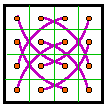 Group I |
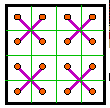 Group II |
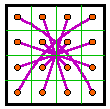 Group III |
 Group IV |
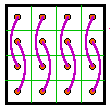 Group V |
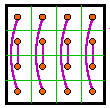 Group VI |
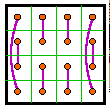 Group VII |
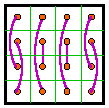 Group VIII |
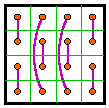 Group IX |
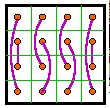 Group X |
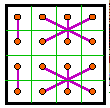 Group XI |
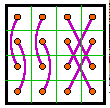 Group XII |
The 12 groups
The 12 groups are classified by the patterns formed by the 8 complement pairs.
A complement pair is two numbers that together sum to n2 + 1. For
order-4 that number is 17.
|
Some comments
Be aware that for some of the normalized magic squares and in some of the transformations to follow, the Dudeney pattern will be rotated from that shown here. Similar patterns may be formed for higher orders as well, although Dudeney only published those for order-4. |
Any magic square can appear in 8 different aspects due to rotations and reflections. For enumeration purposes, one of these 8 squares must be designated as the fundamental or basic one. The other 7 are often referred to as disguised versions of this one.
Frénicle # 175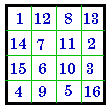 A. |
Rotated 90°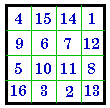 B. |
Rotated 180°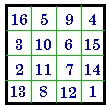 C. |
Rotated 270°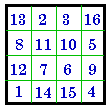 D. |
Dudeney group III E. |
Horizontal Reflection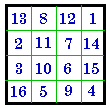 F. |
Vertical Reflection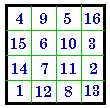 G. |
Vertical then 90°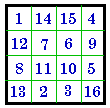 H. |
Horizontal then 90°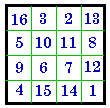 I. Dürer square |
Magic line pattern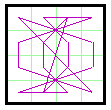 J. for square A. |
Here we use Frénicle's # 175 as an example to illustrate how one fundamental magic
square can also appear in 7 disguised versions. All 8 aspects are Dudeney group
III so are associated magic squares.
Note that whether the magic square is rotated right or left is arbitrary. Here I use right
(clockwise) rotation.
H. may also be considered as reflected around the leading diagonal and I.
as being reflected around the right diagonal .
I. is the magic square from Albrecht Dürer’s engraving, Melancholia,
1514.
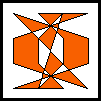 |
The magic line pattern at J. is constructed by
following the magic square numbers of A. in sequence. To the left
is the same diagram with some of the areas filled in. This may be done in various ways to
produce artistic designs. As well as making pretty patterns, these are sometimes used for classification purposes. Jim Moran has a lot of material on these in The Wonders of Magic Squares, Random House, 1982, 0-394-74798-4. He refers to these as sequence designs. |
Normalized position
For enumerating and listing the magic squares of a given order, one of the eight above positions must be designated the normal position. This standard prevents confusion and permits easy comparison. Frénicle established two simple rules to determine the standard position for order-4. These same rules may be used for all other orders as well.
Notice that magic square A. (# 175 above) and # 727 (below) satisfy these two conditions.
| I put a lot of emphasis on the use of index numbers. Otherwise, in comparing lists or tables of magic squares published by different authors, the casual observer is liable to think that the lists are not the same. Magic squares obtained by transformations are usually not normalized. I generally indicate them as disguised and give the index numbers. |
![]()
Normally magic lines are drawn between the centers of the cells. However, this
sometimes results in a longer line hiding a shorter one.
Shown here are two versions of magic line diagrams for magic square #727 (Group VIII).
For interest, each is also shown with some areas filled in, forming a type of abstract
art.
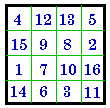 |
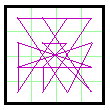 |
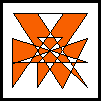 |
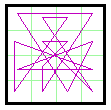 |
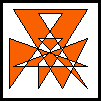 |
In the first line diagram, notice that the top line from 12 to 13 is covered up by the
line from 4 to 5. In fact, it looks like the line goes from 4 to 12 to 13 to 5.
Likewise the left line looks like it is going from 14 to 1 to 15.
These concerns are resolved by offsetting the necessary lines as I did with the second
diagram.
Which method is actually used is a matter of personal preference. The first method
looks tidier because all points appear as on a regular grid pattern. The second method
gives a truer picture.
Any order of magic square may be transformed to another magic square simply by
subtracting each number in turn from
n2 + 1.
The resulting magic square is a disguised version of another magic square belonging to the
same group.
A.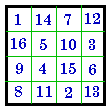 #202 XI |
B.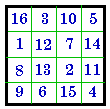 Complement of A. |
C.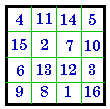 B. Normalized = #724 |
D. Group XI |
E.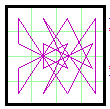 Line pat. for A. & B. |
The resulting magic line diagram will be exactly the same for the original and the
complement magic squares. You simply move around it in the opposite direction. However, it
requires rotation for the normalized version of the complement.
This may be considered complementing the magic square. Robert Sery refers to the process
as complementary pair interchange (CPI).
When complementing some magic squares you end up with the original square except that it is rotated or reflected. Any order of associated (group III) magic square is of this type and the complement will be rotated 180 degrees. Any magic square with a complementary pair pattern like that of group VI also has this self-similar pattern with the complementary reflected either vertically or horizontally, depending on the orientation of the pattern. See my Self-similar page for more information on this type of magic square.
Complementing each number in a magic square will ALWAYS produce a magic square in the
same group.
The following row and column swaps will also always produce an order-4 magic square.
Swap rows and columns 1 and 4
Swap rows and columns 2 and 3.
Change row and column orders to 2, 1, 4, 3.
Change row and column orders to 3, 1, 4, 2.
However, the resulting magic square is likely to belong to a different group. See the bold
lines in the Summary table.
A. # 204 is the pandiagonal magic square example used in
this section.
B. is it's complement, # 744 (disguised). All pandiagonal magic squares
create new pandiagonals when complemented.
C. is the magic square obtained by adding 8 mod(16) to each number. It
also is a disguised # 744. However, complementing and adding 8 mod(16) to
each number sometimes give different magic squares. See. # 117 whose complement is # 483
and +8 is # 646.
D. is obtained by exchanging the two outside columns and also the two
outside rows. However, it is no longer pandiagonal but a group II, (# 63 disguised).
Any magic squares can be transposed to another with this method.
E. is the Dudeney pattern for all pandiagonal (group I) magic squares.
F. is the magic line pattern for the example, # 204. Other pandiagonal
magic squares will have other patterns.
A. #204 I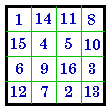 |
B. #744 I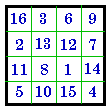 |
C. #744 I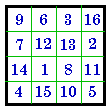 |
D. #63
II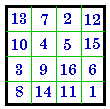 |
E. Type I |
F. for # 204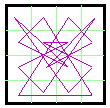 |
Following is a set of 15 transformations that work only with pandiagonal
magic squares and result in other pandiagonal magic squares.
Here we move a row from the top to the bottom of the magic square, a column from the left
to the right, or both a row and a column.
All of these magic squares are disguised except # 469, and of course, the original, # 204.
I have used leading zeros simply to allow simpler formatting.
Rows/columns
No
column change 1 col.
2 col.
3 col.
no row change Original # 204
# 109
#396
#294
01 14 11 08 14 11
08 01 11 08 01 14
08 01 14 11
15 04 05 10
04 05 10 15 05 10 15
04 10 15 04 05
06 09 16 03
09 16 03 06 16 03
06 09 03 06 09 16
12 07 02 13
07 02 13 12 02 13 12
07 13 12 07 02
1 row
# 171
#107
#691
#788
15 04 05 10
04 05 10 15 05 10
15 04 10 15 04 05
06 09 16 03 09 16 03
06 16 03 06 09
03 06 09 16
12 07 02 13 07 02 13
12 02 13 12 07
13 12 07 02
01 14 11 08 14 11 08
01 11 08 01 14
08 01 14 11
2 rows
# 560
#621
#744
#469
06 09 16 03 09
16 03 06 16 03 06 09
03 06 09 16
12 07 02 13 07 02 13
12 02 13 12 07
13 12 07 02
01 14 11 08 14 11 08
01 11 08 01 14
08 01 14 11
15 04 05 10 04 05 10
15 05 10 15 04
10 15 04 05
3 rows
# 532
#839
#355
#292
12 07 02 13
07 02 13 12 02 13
12 07 13 12 07 02
01 14 11 08 14 11 08
01 11 08 01 14
08 01 14 11
15 04 05 10 04 05 10
15 05 10 15 04
10 15 04 05
06 09 16 03 09 16 03
06 16 03 06 09
03 06 09 16
This set contains 16 magic squares out of the 48 pandiagonal magic squares of order-4.
Thus all 48 pandiagonal magic squares can be derived from 3 essentially different magic
squares.
Any one of these 16 magic squares could be considered to be the origin of the set of 16.
If the lowest index number is taken as the starting square, then the other two sets of 16
would start with #104 and # 116.

Here are 15 ways to transform an associated magic square to another
associated magic square (there are many more).
The result is 10 different group III magic squares with 5 of these appearing twice.
Complementing is not included here because, as mentioned previously, you obtain only a
disguised version of the original.
The original is normalized as are 2 of the resulting magic squares. The other 13 are all
disguised versions of their index number.
#126 III #124 Exchange #206 Exchange #183 Exchange rows Original rows 1 and 4 columns 1 and 4 and columns 1 and 4 1 8 15 10 7 2 9 16 10 8 15 1 16 2 9 7 14 11 4 5 14 11 4 5 5 11 4 14 5 11 4 14 12 13 6 3 12 13 6 3 3 13 6 12 3 13 6 12 7 2 9 16 1 8 15 10 16 2 9 7 10 8 15 1 #206 Exchange #478 Exchange rows #308 Swap col. 1 and 2 #632 Swap rows and columns 2 and 3 1 and 2 with 3 and 4 with col. 3 and 4 col. 1 and 2, 3 and 4 1 15 8 10 12 13 6 3 15 10 1 8 6 3 12 13 14 4 11 5 7 2 9 16 4 5 14 11 9 16 7 2 12 6 13 3 1 8 15 10 6 3 12 13 15 10 1 8 7 9 2 16 14 11 4 5 9 16 7 2 4 5 14 11 #124 Exchange #789 Move quadrants #289 Move quadrants #632 Swap kitty- rows 2 and 3 clockwise counter-clockwise corner quadrants 1 8 15 10 12 13 1 8 15 10 6 3 6 3 12 13 12 13 6 3 7 2 14 11 4 5 9 16 9 16 7 2 14 11 4 5 6 3 15 10 1 8 12 13 15 10 1 8 7 2 9 16 9 16 4 5 14 11 7 2 4 5 14 11 #183 Swap columns #478 swap rows #395 swap columns #741 Swap columns and and rows 2 and 3 1 and 2, 3 and 4 1 and 2, 3 and 4 rows 1 and 2, 3 and 4 1 15 8 10 14 11 4 5 15 1 10 8 4 14 5 11 12 6 13 3 1 8 15 10 4 14 5 11 15 1 10 8 14 4 11 5 7 2 9 16 6 12 3 13 9 7 16 2 7 9 2 16 12 13 6 3 9 7 16 2 6 12 3 13
In almost all cases, the resulting magic square will be a disguised version of the index number shown.
Between Group I and II by exchanging rows 2 and 3 and
columns 2 and 3.
Each of the 48 group I magic squares transforms to one of the 48 group II.
In this and all following cases the transformation works in reverse, so in this case,
group II can also be transformed to group I
#171 I |
Group I |
Exchange rows 2 & 3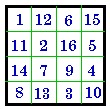 |
and col. 2 & 3 = #57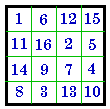 |
Group II |
The same result is obtained by swapping rows and columns 1 and 4 instead of 2 and 3. The same index number magic square is obtained but it is a reflected version.
![]()
Between Group II and III by exchanging rows 1 and 3 and
columns 1 and 3.
Each of the 48 group II magic squares transforms to one of the 48 group III.
#213 II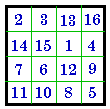 |
Group II |
Exchange rows 1 & 3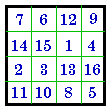 |
and col. 1 & 3 = # 808 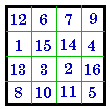 |
Group III |
The same result is obtained by swapping rows and columns 2 and 4 instead of 1 and 3. This time a different magic square is obtained. From #213 it would be #361.
![]()
Between Group I and Group III using quadrants to rows
or rows to quadrants.
There are 48 magic squares of Group I and 48 of Group III. Each of these may be
transformed from one type to a magic square of the other type by the following procedure.
See A. and B. Use the same procedure but start at a different number in the quadrants (or
rows) to get three more squares of the second type from the one original.
A. #183
III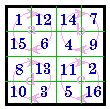 |
B. #171
I |
Using #183 Group III for our original, construct #171 Group I by taking the four numbers in turn from each quadrant to form the four lines of # 171. C. and D. are the Dudeney patterns for the two magic squares. E. F. and G. illustrate how we can get three more pandiagonal magic squares from the same associated magic square, by simply starting at a different cell in the original. |
||
C. Type III |
D. Type I |
E. #204
I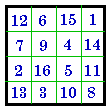 |
F. #532
I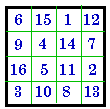 |
G. #560
I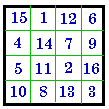 |
H. #171
I |
J. #183
III |
#808 III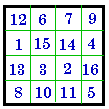 |
#698 III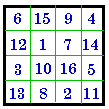 |
#361 III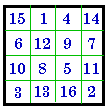 |
Those first 4 pandiagonal magic squares were obtained by starting with quadrant a. of the original associated magic square. By repeating the procedure but starting with quadrant b., then c. and finally d., 12 more pandiagonal magic squares are obtained. In fact we end up with the same set of 16 squares that were obtained by shifting rows and/or columns (proceeding section).
The bottom row illustrates how by reversing the process, four associated
magic squares can be formed from one pandiagonal magic square.
Simply form the 4 quadrants of J. in turn from the 4 rows of H. to get back to the
original associated square. The other 3 squares are formed by starting each quadrant from
a different position in the row. And by starting with a different quadrant we end up
with 16 associated magic squares generated by 1 pandiagonal.
If we try the same procedure on any of the other 15 pandiagonal magic squares obtained
above, we obtained disguised versions of the same 16 associated magic squares.
Another method (not shown). Exchange the last two columns, then exchange the last two rows, to convert magic squares between Group I and Group III.
![]()
Between Group IV and Groups V and VI interchanging rows
(and columns)
There are 96 magic squares of Group IV. Each of these may be transformed to one
of the 96 magic squares of Group V and to one of the 96 magic squares of Group VI. Here we
use Group IV #251 as an example.
#251 IV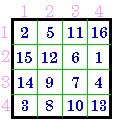 |
Group IV |
exchange rows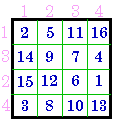 |
& columns = # 356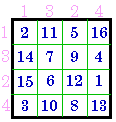 |
Group V |
| To transform from a Group IV to a Group V simply exchange rows
2 & 3 and columns 2 & 3. To transform from a Group IV to a Group VI simply exchange rows 2 & 4 and columns 2 & 4. |
Exchange rows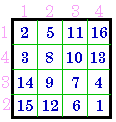 |
& columns = #227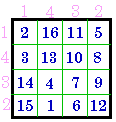 |
Group VI |
|
Note that this transformation works in both directions i.e. also from V or VI to IV.
However, for Group VI, it works only on the 96 that are semi-pandiagonal. On the 208
simple magic squares of order-VI, the result of this transformation is only
semi-magic.
![]()
Between Group VII and Groups VIII, IX and X
There are 56 magic squares of Group VII. Each of these may be transformed to
magic squares of Groups VIII, IX or X by simple permutation of rows and columns.
#717 VII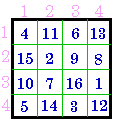 |
Group VII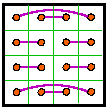 |
change row order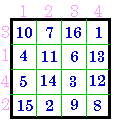 |
& columns = # 332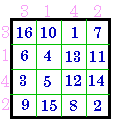 |
Group VIII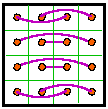 |
| To transform from a Group VII to a Group VIII
change row and column order to 3, 1, 4, 2. To transform from a Group VII to a Group XI change row and column order to 2, 1, 4, 3. To transform from a Group VII to a Group X exchange rows 2 & 3 and columns 2 & 3. Note that for each of these four magic squares the Dudeney pattern is rotated 90 degrees from that shown by Dudeney (although in the case of #373, if the square is normalized the Dudeney pattern would be correctly orientated). |
change row order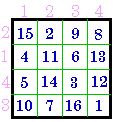 |
& columns = # 373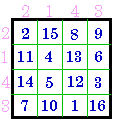 |
Group IX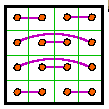 |
|
exchange rows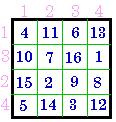 |
& columns = # 652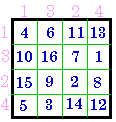 |
Group X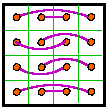 |
||
![]()
Between Group XI and Group XII
There are 8 magic square each of Groups XI and XII. Magic squares of one group
may be transformed to magic squares of the other group by exchanging rows 2 & 4 and
columns 2 & 4.
#374 XI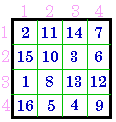 |
Group XI |
exchange rows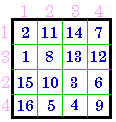 |
& columns = # 209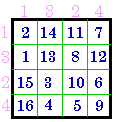 |
Group XII |
![]()
Please send me Feedback about my Web
site!

![]()
![]()
![]()
Last updated
September 01, 2009
Harvey Heinz harveyheinz@shaw.ca
Copyright © 1998, 2000 by Harvey D. Heinz